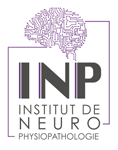2-Aminothiazole-Flavonoid Hybrid Derivatives Binding to Tau Protein and Responsible for Antitumor Activity in Glioblastoma
Résumé
Tau protein has been described for several decades as a promoter of tubulin assembly into microtubules. Dysregulation or alterations in Tau expression have been related to various brain cancers, including the highly aggressive and lethal brain tumor glioblastoma multiform (GBM). In this respect, Tau holds significant promise as a target for the development of novel therapies. Here, we examined the structure–activity relationship of a new series of seventeen 2-aminothiazole-fused to flavonoid hybrid compounds (TZF) on Tau binding, Tau fibrillation, and cellular effects on Tau-expressing cancer cells. By spectrofluorometric approach, we found that two compounds, 2 and 9, demonstrated high affinity for Tau and exhibited a strong propensity to inhibit Tau fibrillation. Then, the biological activity of these compounds was evaluated on several Tau-expressing cells derived from glioblastoma. The two lead compounds displayed a high anti-metabolic activity on cells related to an increased fission of the mitochondria network. Moreover, we showed that both compounds induced microtubule bundling within newly formed neurite-like protrusions, as well as with defection of cell migration. Taken together, our results provide a strong experimental basis to develop new potent molecules targeting Tau-expressing cancer cells, such as GBM.
Fichier principal
 ijms-2634375-2-Aminothiazole-Flavonoid Hybrid.pdf (1.79 Mo)
Télécharger le fichier
ijms-2634375-2-Aminothiazole-Flavonoid Hybrid.pdf (1.79 Mo)
Télécharger le fichier
| Origine | Fichiers produits par l'(les) auteur(s) |
|---|---|
| licence |


